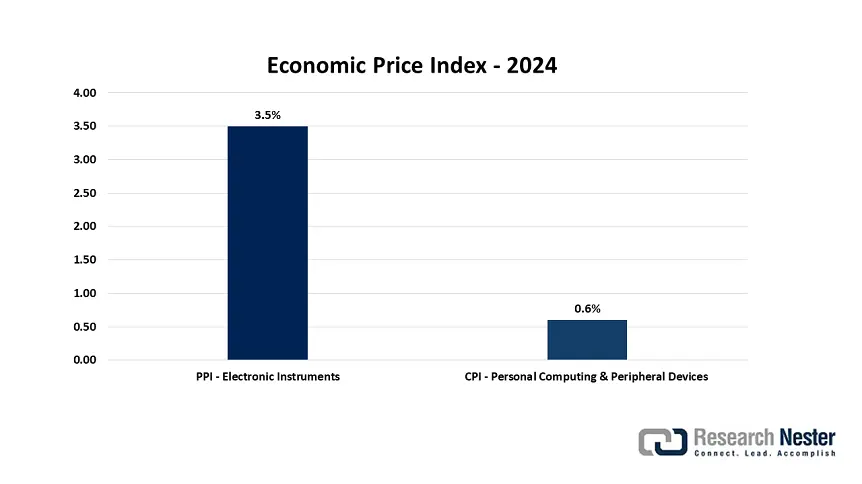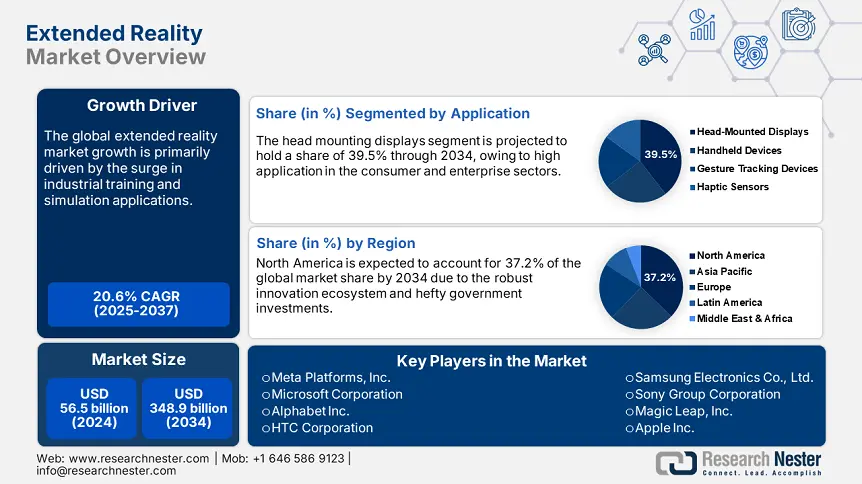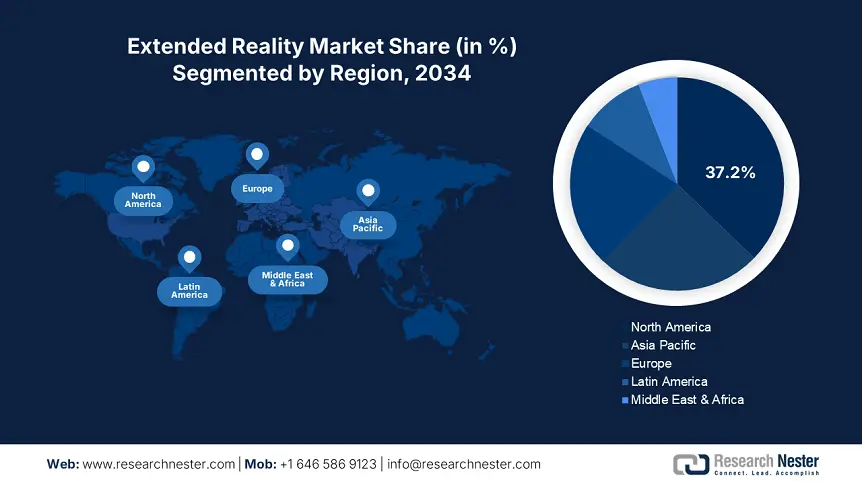Extended Reality Market Outlook:
Extended Reality Market size was valued at USD 56.5 billion in 2024 and is projected to reach USD 348.9 billion by the end of 2034, rising at a CAGR of 20.6% during the forecast period, i.e., 2025 to 2034. In 2025, the industry size of extended reality is estimated at USD 67.6 billion.
The global trade of extended reality is heavily reliant on the supply chain of optical components, sensors, semiconductors, and display technologies, all primarily sourced from East and Southeast Asia. The U.S. International Trade Commission (USITC) states that the imports of XR-enabling components, including CMOS sensors, LCD panels, and microelectromechanical systems (MEMS), reported a cumulative rise of more than 18% between 2021 and 2023, underlining robust production activity driven by OEM demand. Furthermore, the U.S. Census Bureau reveals that in 2024, imports of optical instruments and lenses were calculated at USD 4.3 billion, a 9.5% year-over-year hike. This highlights that stable production of raw materials is directly creating a profitable environment for extended realty companies.

The U.S. domestic production of electronic components rose by 5.5% during the fourth quarter of 2024, largely due to the rising demand in immersive tech segments. This growth is reflected in the producer price index (PPI) for electronic instruments, which grew by 3.5% YoY. While the consumer price index (CPI) for personal computing and peripheral devices remained relatively stable, with a marginal 0.6% rise in 2024, signifying consistent end-user pricing despite global component cost pressures.

Extended Reality Market - Growth Drivers and Challenges
Growth Drivers
- Surge in industrial training and simulation applications: The manufacturing, defense, and education sectors are set to drive the sales of extended reality technologies in the coming years. The extended reality solutions are gaining traction owing to the immersive simulation training that reduces operational risk and cost. The study by the National Institute of Standards and Technology (NIST) reveals that the extended reality adoption in manufacturing training enhances knowledge retention by up to 75.5% compared to traditional methods. In the defense sector, the U.S. Army’s Synthetic Training Environment (STE) program is expected to allocate more USD 22.3 billion in XR-based training in the coming 10 years. Moreover, the government support and digitalization moves are expected to propel the sales of extended reality solutions going ahead.
- Increasing use of XR in healthcare diagnostics and therapy: The healthcare sector is estimated to propel the trade of extended reality in the coming years, as these technologies are widely used in physical therapy, pain management, and surgical training. Continuous innovations are accelerating the application of both augmented and virtual reality solutions in healthcare settings. The U.S. Department of Veterans Affairs has expanded its use of XR for PTSD therapy across more than 69 medical centers. Also, the same trend is followed by NHS England, where they are trialing XR for remote stroke rehabilitation. The healthcare XR is anticipated to increase at a CAGR of 27.5% through 2030. Overall, medical settings are poised to double the revenues of key players during the forecast period.
Technological Innovations in the Extended Reality Market
The edge computing, AI-driven spatial mapping are expected to boost the efficiency of extended reality solutions. The telecom, healthcare, manufacturing, and retail industries are estimated to propel the demand for extended reality technologies. The continuous investments in technological innovations are further set to double the revenues of key players. The table below reveals the current technological trends and their outcomes.
|
Technology Trend |
Sector |
Company Example |
2024 Impact/Stat |
|
AI-based Spatial Mapping |
Healthcare |
Medivis |
32.5% rise in surgical planning efficiency |
|
Cloud XR Rendering |
Telecom |
Telefónica |
19.2% growth in XR content delivery to consumers |
|
Edge Computing |
Retail |
Walmart |
25.5% latency fall in XR shopping trials |
AI & ML Trends Shaping the Market
|
Company |
Integration of AI & ML |
Outcome |
|
Microsoft (HoloLens) |
Used AI-driven spatial mapping & ML-enhanced user interaction tracking for HoloLens 2 |
Reduced development time by 21% using AI-based simulation & testing |
|
Unity Technologies |
Implemented ML agents to train XR environments and AI-driven asset optimization tools |
Cut 3D content creation costs by 31% and accelerated iteration cycles |
|
PTC (Vuforia) |
Integrated AI for object recognition and ML for real-time analytics in industrial AR |
Improved field service productivity by 34%, lowering support costs |
|
Snap Inc. (AR Lenses) |
Used neural networks and ML to optimize AR lens personalization and performance |
Enhanced user engagement by 24%, reduced rendering time by 18% |
|
HTC Vive |
Employed AI-powered predictive maintenance in XR hardware logistics |
Achieved 22% drop in logistics costs through AI-based supply chain optimization |
|
Varjo |
Applied deep learning for gaze-tracking precision and XR image enhancement |
Increased product quality by 19.8%, improving B2B customer satisfaction |
Challenges
- High cost of XR hardware and pricing pressure: The production of extended reality solutions is a capital-intensive process due to the involvement of specialized components such as OLED microdisplays, spatial tracking sensors, and custom silicon chips. These raw materials add up to the final product costs, limiting their adoption in budget-constrained sectors and businesses. The average retail price of enterprise-grade XR headsets surpasses USD 1,100, restricting their accessibility among SMEs. The World Trade Organization (WTO) states that tariffs on electronics imports in emerging markets, including Brazil and India, can add 21% to 31% to unit costs, worsening affordability.
- Data protection regulations and compliance complexity: The EU’s General Data Protection Regulation (GDPR) and India's Digital Personal Data Protection Act impose strict user consent and data residency rules. The data privacy regulations further create compliance requirements for extended reality platforms that handle sensitive biometric and spatial data. This limits the transfer of personal information across jurisdictions, hindering the sales of extended reality solutions. For instance, in 2023, Meta had to pause XR product rollouts in Germany and France for 8 weeks due to non-compliance with local interpretations of GDPR spatial tracking consent. Thus, strict data regulations are likely to hamper product innovation and time-to-market.
Extended Reality Market Size and Forecast:
| Report Attribute | Details |
|---|---|
|
Base Year |
2024 |
|
Forecast Year |
2025-2034 |
|
CAGR |
20.6% |
|
Base Year Market Size (2024) |
USD 56.5 billion |
|
Forecast Year Market Size (2034) |
USD 348.9 billion |
|
Regional Scope |
|
Extended Reality Market Segmentation:
Hardware Segment Analysis
The head-mounted displays (HMDs) segment is projected to capture 39.5% of the global market share by 2034, owing to rising applications in the consumer and enterprise sectors. The sales of head-mounted displays are also influenced by their affordability, better ergonomics, and 5G-compatible units. In July 2025, VITURE announced the launch of Luma Pro and Luma Ultra XR glasses, targeting both consumers and the gaming market.
Application Segment Analysis
The gaming & entertainment segment is anticipated to hold 30.1% of the global market share throughout the forecast period. The gaming craze among youngsters and adults is creating a profitable environment for extended reality technology manufacturers. The robust rise in the entertainment sector, both the OTT and TVOD platforms, is propelling the adoption of extended reality solutions. According to the National Endowment for the Arts, the immersive media grants boosted the development of interactive XR experiences, particularly in the U.S. independent content market in 2024. Overall, the gaming and entertainment sectors are most lucrative for extended reality companies.
Our in-depth analysis of the global market includes the following segments:
|
Segment |
Subsegments |
|
Hardware |
|
|
Application |
|
|
End user |
|

Vishnu Nair
Head - Global Business DevelopmentCustomize this report to your requirements — connect with our consultant for personalized insights and options.
Extended Reality Market - Regional Analysis
North America Market Insights
The North America extended reality market is expected to account for 37.2% of the global revenue share through 2034. The robust innovation ecosystem and sustained government investment in ICT infrastructure are propelling the adoption of extended reality solutions. The easy availability of wireless connectivity networks and early adopters are also estimated to fuel the sales of extended reality technologies. FCC's Affordable Connectivity Program is boosting the XR accessibility for underserved populations in the U.S. The digital accessibility policies that favor XR deployment in schools and public institutions are further poised to double the revenues of key players in the years ahead.
The large-scale defense contracts and immersive content creation activities are likely to amplify the sales of extended reality solutions in the U.S. The rise in edge computing infrastructure is also contributing to the increasing demand for extended reality solutions. As reported by the Department of Defense's HoloLens deployment and VR training simulations for the Air Force, more than 2.3 billion was invested in federal defense contracts, including XR-related technologies, in 2023. In addition, the gaming, defense, and telemedicine sectors are opening high-earning opportunities for extended reality companies.
Europe Market Insights
The Europe extended reality market is estimated to account for 27.9% of the global revenue share throughout the study period. The robust government support, growing digital infrastructure investments, and strong adoption across the enterprise and public sectors are amplifying the sales of extended reality solutions in the years ahead. The UK, Germany, and France are some of the leading marketplaces in the region. European Commission states that the EU allocated over €4.2 billion in 2023 under the Digital Europe Programme and European Digital Innovation Hubs (EDIHs) to support XR and AI development across member states. The hefty ICT budgets are promoting the adoption of extended reality solutions.
Germany holds a dominant Europe market share owing to a robust industrial base and consistent public-sector investments. The digital transformation agendas are accelerating the production and commercialization of extended reality technologies. The government’s €3.5 billion in XR infrastructure and software in 2024 mainly influenced the sales of extended reality solutions. The automotive, manufacturing, and healthcare sectors are prime end users of extended reality solutions. Furthermore, public investments such as the Smart Germany initiative are subsidizing XR integration in more than 119 municipalities.
Country-Specific Insights
|
Country |
2024 Govt. ICT Budget Allocation to XR |
Spending Increase (2024) |
Key Adoption Trends (2023-2024) |
|
France |
€2.2 billion |
↑16.5% |
Over 510 schools & 220 hospitals using XR for training & diagnostics |
|
United Kingdom |
£1.8 billion (~€2.1B) |
↑15.7% |
Education XR rollout in 600+ institutions under DSIT & DfE initiatives |
|
Italy |
€950.5 million |
↑14.2% |
XR adoption in defense & smart tourism, supported by the NRRP tech modernization fund |
|
Spain |
€780.2 million |
↑19.7% |
XR used in cultural heritage, language learning & SME productivity programs. |
|
Netherlands |
€540.4 million |
↑11.9% |
XR used in higher education and agriculture simulations |
APAC Market Insights
The Asia Pacific extended reality market is foreseen to increase at a CAGR of 19.5% from 2025 to 2034 due to large-scale government investments, swift digitalization, and widespread enterprise adoption. China, Japan, India, and South Korea are leading marketplaces offering high returns on investments. Substantial ICT allocations toward XR hardware, a rise in digital learning, and automation trends are propelling the sales of extended reality solutions during the forecast period. The favorable government policies and positive foreign direct investments are further expected to accelerate the manufacturing and commercialization of extended reality solutions.
The government-led industrial automation, smart city programs, and educational digitization moves are boosting the sales of extended reality technologies in China. Nearly USD 3.5 billion was invested in XR R&D and deployment in 2024. The number of XR-integrated enterprises in the country surpassed 1.8 million in 2023, largely driven by logistics, automotive, and healthcare sectors. The Digital Silk Road and Made in China initiative are further set to drive innovations in the extended reality solutions. The strong presence of high-tech end users is poised to double the revenues of key players in the years ahead.
Country-Specific Insights
|
Country |
2024 XR Spending |
CAGR |
Key Adoption Metric (2023) |
|
Japan |
$2.5 billion |
15.48% (2022-24) |
6.3% of the ICT budget for XR |
|
India |
$1.2 billion |
13.49% (2015-23) |
2.2M SMEs using XR in training, upskilling |
|
South Korea |
$1.7 billion |
11.3% est. |
Strong adoption in smart defense and education |
|
Malaysia |
$344 million |
11.5% est. |
600+ orgs onboarded under IR4.0 by 2023 |

Key Extended Reality Market Players:
- Company Overview
- Business Strategy
- Key Product Offerings
- Financial Performance
- Key Performance Indicators
- Risk Analysis
- Recent Development
- Regional Presence
- SWOT Analysis
The global market is characterized by the presence of gigantic companies and the increasing emergence of start-ups. Leading companies are holding domain share through immersive ecosystem development and software platform integration. They are continuously investing in advanced technologies to boost the efficiency of their products and reach a wider consumer base. Some industry giants are entering into strategic partnerships with other players to boost their profits. Collaborations with raw material suppliers are also expected to offer smooth production cycles to key players. Furthermore, the organic marketing strategies are likely to double the revenues of leading companies in the coming years.
Here is a list of key players operating in the global extended reality market:
|
Company Name |
Country of Origin |
Revenue Share 2024 |
|
Meta Platforms, Inc. |
USA |
14.5% |
|
Microsoft Corporation |
USA |
11.9% |
|
Alphabet Inc. (Google) |
USA |
9.7% |
|
HTC Corporation |
Taiwan |
8.4% |
|
Samsung Electronics Co., Ltd. |
South Korea |
8.0% |
|
Sony Group Corporation |
Japan |
xx% |
|
Magic Leap, Inc. |
USA |
xx% |
|
Apple Inc. |
USA |
xx% |
|
Varjo Technologies Oy |
Finland |
xx% |
|
Lynx (SystemActive) |
France |
xx% |
|
Tata Elxsi Ltd. |
India |
xx% |
|
Vection Technologies Ltd. |
Australia |
xx% |
|
Globetronics Technology Berhad |
Malaysia |
xx% |
|
Canon Inc. |
Japan |
xx% |
|
Panasonic Holdings Corporation |
Japan |
xx% |
|
Meta Platforms, Inc. |
USA |
xx% |
|
Microsoft Corporation |
USA |
xx% |
|
Alphabet Inc. (Google) |
USA |
xx% |
|
HTC Corporation |
Taiwan |
xx% |
|
Samsung Electronics Co., Ltd. |
South Korea |
xx% |
Below are the areas covered for each company in the Extended Reality Market:
Recent Developments
- In May 2024, Meta Platforms, Inc. announced the expansion of its Quest for Business platform across Europe and Asia. The company reported a 17.5% rise in enterprise XR subscriptions in the second quarter of 2024.
- In April 2024, Microsoft Corporation updated its Mesh for Teams platform to include AI-powered avatars and real-time speech translation for over 20 languages. This enhancement led to the rise in the adoption of Mesh by 36.5% among Fortune 500 companies in the first half of 2024.
- In February 2024, Apple Inc. introduced the Vision Pro mixed reality headset, marking its first major foray into the XR space. The release of this solution led to a 9.5% revenue growth in the first quarter of 2024.
- Report ID: 4863
- Published Date: Jul 15, 2025
- Report Format: PDF, PPT
- Get detailed insights on specific segments/region
- Inquire about report customization for your industry
- Learn about our special pricing for startups
- Request a demo of the report’s key findings
- Understand the report’s forecasting methodology
- Inquire about post-purchase support and updates
- Ask About Company-Level Intelligence Additions
Have specific data needs or budget constraints?
Frequently Asked Questions (FAQ)
Extended Reality Market Report Scope
FREE Sample Copy includes market overview, growth trends, statistical charts & tables, forecast estimates, and much more.
Connect with our Expert
 Inquiry Before Buying
Inquiry Before Buying


